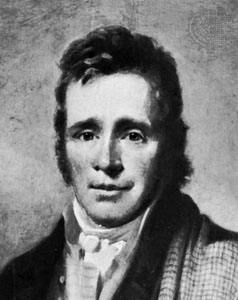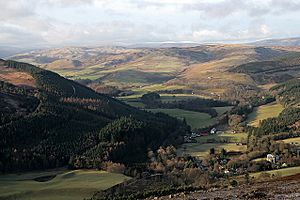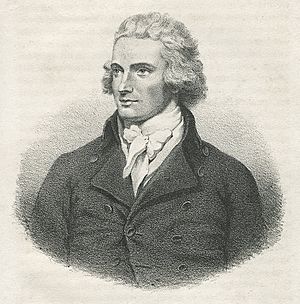Yarrow Water facts for kids
The Yarrow Water is a river in the Scottish Borders, located in the southeast of Scotland. It flows into the Ettrick Water, which then joins the larger River Tweed. The Yarrow Water is famous for its excellent trout and salmon fishing. The name "Yarrow" might come from an old Celtic word, garw, which means "rough."
The valley around the Yarrow Water is a special place. It was the birthplace of the famous explorer Mungo Park. Many well-known songs and poems have been inspired by this river and its surroundings. The traditions and folk tales of the area were carefully written down by Walter Scott, a famous Scottish writer. He spent some of his childhood nearby and later lived at Abbotsford House, close to Melrose.
Contents
Where the Yarrow Water Flows
The Yarrow Water begins at St Mary's Loch. From there, it flows east for about 20 kilometers (12 miles). As it travels, the river drops about 123.5 meters (405 feet). It passes by small places like Yarrow Feus, Yarrow, and Yarrowford.
The river then meets the Ettrick Water near where the Battle of Philiphaugh took place in 1645, just west of Selkirk. This meeting point is called the Meetings Pool. A road, the A708, follows the valley from Selkirk to Moffat.
Famous People of the Yarrow Valley
The explorer Mungo Park was born in 1771 at Foulshiels, right by the river. A story tells how in 1804, Walter Scott saw Park throwing stones into a deep part of the river. Scott thought it was a strange thing for an explorer to do. Park explained that this was how he used to check how deep rivers were in Africa. At that time, Park was secretly planning his second big trip, which sadly was his last.
Around the same time, another famous writer, James Hogg, known as "The Ettrick Shepherd," became friends with Walter Scott. Hogg worked on a farm called Blackhouse Farm in the Yarrow valley.
Newark Castle
The impressive ruins of Newark Castle stand on the right bank of the river, across from Foulshiels. This castle was once owned by the Earls of Douglas in the 1400s.
Yarrow in Stories and Songs
The Yarrow Water has inspired many famous songs and poems over the years.
The Dowie Dens o Yarrow
"The Dowie Dens o Yarrow" is a sad folk song. Its name means "the dismal, narrow wooded valleys of Yarrow." The song tells a story of an ambush and murder that happens in the area. Walter Scott believed the song was based on a real event from the 1600s.
The Sang of the Outlaw Murray
"The Sang of the Outlaw Murray" is an old poem collected by Walter Scott. Local stories say the events in the poem happened near Newark Castle. However, Scott thought the true location was an old tower at Hangingshaw, near Yarrowford.
William Wordsworth's Poems

The famous poet William Wordsworth wrote three poems about the Yarrow. In his 1803 poem "Yarrow Unvisited," he wrote:
- "What's Yarrow but a river bare,
- That glides the dark hills under?
- There are a thousand such elsewhere
- As worthy of your wonder.
Even though he wrote this, he visited the area twice more! He traveled along the Yarrow with James Hogg. This led to his poems "Yarrow Visited" (1814) and "Yarrow Revisited" (1838).
In 1835, Wordsworth wrote a poem about the death of James Hogg. It included these lines:
- "The mighty Minstrel breathes no longer,
- 'Mid mouldering ruins low he lies;
- And death upon the braes of Yarrow,
- Has closed the Shepherd-poet's eyes."
Tam Lin
The wood of Carterhaugh, where the Yarrow and Ettrick rivers meet, is the setting for the old song "Tam Lin". This song, first written down in 1729, tells the story of a young woman and her connection to the faery world. It starts like this:
- "O I forbid you, maidens a',
- That wear gowd on your hair,
- To come or gae by Carterhaugh,
- For young Tam Lin is there.
- There's nane that gaes by Carterhaugh
- But they leave him a wad,
- Either their rings, or green mantles,
- Or else their maidenhead."
This story might have come from an even older song from the 1200s, "Thomas the Rhymer." That song is about Thomas Learmonth from nearby Erceldoune.
Local Folk Tales
The story of Tam Lin is connected to other local traditions. Walter Scott wrote that people would point out "fairy rings" in the fields of Carterhaugh. These are circles where people believed fairies danced. They said that the grass would never grow on these spots.
Scott also mentioned that people in Selkirkshire strongly believed in fairies. He shared a story that many people believed happened in the 1600s on Peat Law, a hill near Foulshiels Hill.
The story tells of a poor man who was pulling heather on Peat Law. He got tired and fell asleep on a fairy ring. When he woke up, he was shocked to find himself in a big city he had never seen before! His coat was still on Peat Law, and his hat, which fell off during his "air journey," was later found hanging on the church steeple in Lanark.




